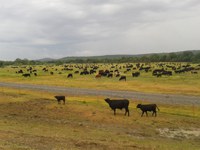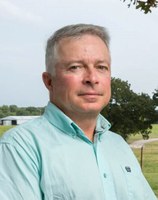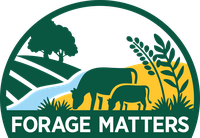Forage Matters: Are you moving forward?
(Click an image below to view a high-resolution image that can be downloaded)
By James Rogers, Forage crops production specialist
NDSU Extension
Today is a great day to be in the office — as I sit here, writing this column, I’m watching it rain! This rain is our first significant moisture event since half an inch fell in early April. Up to this point, it has been a dry year. A rainy day is also a good time to do a bit of reflection on the past, present and future of forages and grazing management.
Terminology is a good place to start. Several years ago, at a national meeting of grazing lands scientists, forage and grazing land scientists from across the country noted that they were using different terms to describe animal grazing and grazing lands. This discussion eventually led to a publication titled "An international terminology for grazing lands and grazing animals."
In this publication, there are definitions for many common grazing terms such as stocking rate, animal unit, forage, preference and rest period. Since this is international terminology, there are also uncommon terms that are defined, like transhumance systems, grazing station and veld. By using defined terminology, communication and clarity among grazing land scientists have improved and have moved forward.
Grazing systems also have a wide range of terminology. Last winter meeting season, I gave several talks on grazing management. In preparation, I tried to find as many named grazing systems as possible. I came up with 18 named systems, and I am probably low on my count, as there are variations of each. Some of the more commonly named systems are rotation, adaptive and management-intensive grazing. Each of these systems will have advocates and detractors, as well as advantages and disadvantages, but is there a commonality among them? If we are talking about perennial grazing lands, either introduced or native, then I would argue the answer is yes.
A commonality of these grazing management systems is that they all strive to maintain healthy, deep-rooted plants that produce sufficient quality biomass to sustain grazing livestock. Healthy plants plus healthy soils equals healthy livestock. In addition, these systems strive to keep the soil covered or "armored," increase rainfall capture, capture carbon, provide habitat for creatures above and below the ground, eliminate soil movement and provide a host of other ecosystem services.
These systems also must provide an economic return to the manager; otherwise, they are not sustainable. The idea behind these systems is that, when managed correctly, they control grazing intensity and duration (a complicated way of saying how often a forage plant is grazed and how close to the ground it is grazed). This, in turn, influences plant persistence, regrowth, carbohydrate storage and accumulation, root depth and other plant response factors.
These systems also incorporate plant recovery time, allowing plants to recover from a grazing event. Not all forage plants are designed the same way, with some built to withstand grazing pressure better than others. A grazing management goal is to keep forage plants on an even playing field in terms of competitiveness.
Another commonality with these systems is that the stocking rate must be appropriate to function correctly. The land area allocated to the animal must produce sufficient forage to support the animal and the forage plants during the grazing season. Stocking rate and stocking density, while related, refer to different concepts. High stocking density may be used as a tool to achieve a specific land management goal and is usually described in pounds of live weight per acre. A one-acre paddock with one hundred 1,000-pound cows would have a stock density of 100,000 pounds/acre. If this one-acre paddock is part of a 100-acre grazing area, the stocking rate would be one acre/cow. Typically, if high stock density is applied to an area, recovery time needs to be adjusted based on grazing intensity and plant species.
The approach to implementing grazing management can be holistic, regenerative or common sense, but with all these strategies, the outcome should be that you are moving forward. "Moving forward" means that improvements are made to the system as a whole over time. All these approaches are not just about forage management as they have impacts and ripple effects throughout the entire operation. Animal and plant production, soil health, water quality and economics all should be moving forward.
Are we moving forward? Yes, we are. There are many more tools for grazing managers to use now than a decade ago. Fencing systems have improved, and virtual fencing is a major step forward that opens many land management doors. Tools for monitoring and establishing baselines have become easier to use. Grazing management information has never been more abundant, but there are still issues. Soil erosion is still a problem and may even be increasing as we look across the landscape. We still have dust storms. Forage supply and animal demand can be mismatched.
Keep moving forward. There is no one-size-fits-all grazing management approach. Hopefully, you will notice how frequently the word "management" is used in this column. All these approaches have to be managed and tweaked based on the individual's land management goals and needs. Commonality exists across these approaches; each can be a valuable tool to keep land management moving forward.
(James Rogers is a North Dakota State University Extension forage crops production specialist at the North Central Research Extension Center near Minot, North Dakota.)
NDSU Agriculture Communication – May 23, 2025
Source: James Rogers, 580-857-7682, james.rogers1@ndsu.edu
Editor: Dominic Erickson, 701-231-5546, dominic.erickson@ndsu.edu




